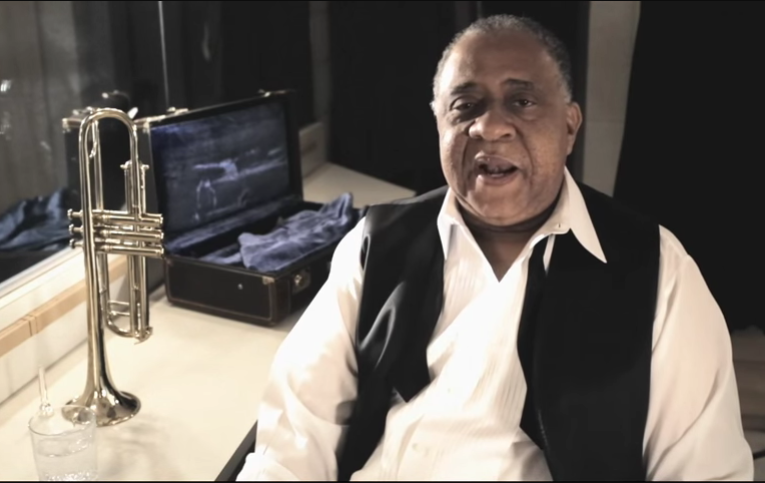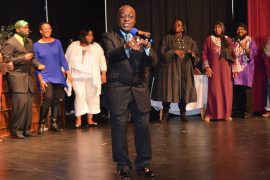I thought Satchmo At The Waldorf would be a play about Louis Armstrong and his music. It is not.
It is a drama about his life. This is a brilliant play about the man behind the scenes telling the real life sentiment of a musical genius, Louis Armstrong.
The play is fictional, but it is real – real fiction. The one-act, one-man play is brilliantly performed by Barry Shabaka Henley. In a word, he is amazing, playing four characters.
The play takes place in the dressing room of the Waldorf Astoria Hotel four months before Armstrong’s death in 1971. It is Satchmo’s last performance and he reflects over his life.
 He is tape-recording his life memories. (In real life, Louis Armstrong was one of the first people in America to own a tape recorder.) He is reflective about his life, his contribution to jazz, his music, his philosophy of life and his friendships.
He is tape-recording his life memories. (In real life, Louis Armstrong was one of the first people in America to own a tape recorder.) He is reflective about his life, his contribution to jazz, his music, his philosophy of life and his friendships.
Through his recounts, we get Armstrong’s life though his own lens. His philosophy is simple: “I am here in the cause of happiness.”
His is a story that makes you laugh, cry and reflect. This is a story about race relations in America and how a talented, gifted Black man coped to compensate for that racism so that he could play his horn, so that he could work.
It is a story about the reality of show business and how many Black entertainers were taken advantage of by White, mostly Jewish, managers. It is a story about the gangsters behind the scenes and the dynamics of how the club life really worked.
The Artist As A Young Man
Louie Armstrong damn near invented the jazz concept. He was the master of improvisation. He was born in New Orleans and he had a hard childhood, coming from a poor family.
He worked for a Jewish immigrant family as a young child as a junk peddler; they treated him respectfully and included him at their table. They bought him his first horn. He discovered the horn in a detention home.
He traveled to Chicago as a young man and while working for Al Capone, he had a booking conflict of play dates with a New York club. Satch obviously had a choice between the gangster in New York or the gangster in Chicago.
Realizing he needed management so that he could concentrate on playing his horn and leave the business to someone else, he hired Joe Glaser to manage his business and what amounted to his life.
Glaser managed Al Capone’s club. They became partners who split the money right down the middle. Glaser kept Armstrong working on the road from little towns to big city stages. Theirs was a genuine friendship. Glaser said, according to Armstrong, let’s make money.
Glaser told Armstrong to play his horn and keep a smile on his face. Make people happy. His audiences were mostly White. Armstrong was obedient to Glaser throughout his career, with only a handshake agreement. But his career soared.
Smiling And Grinning
Smiling and grinning, Armstrong was mischaracterized and misinterpreted as a “darkie” and an “Uncle Tom.” Miles Davis was a publicly critical voice of Armstrong. He spoke to his image more than he did his brilliant musicianship.
Miles said you don’t have to come on stage and grin, just play. Miles was popular for turning his back to his audiences in his performances. Maybe Armstrong helped shaped Miles’ stage presence as an act of rebellion.
Armstrong himself usually worked usually one-night gigs 300 days of the year. He was clearly a White audience favorite.
The story in Satchmo At The Waldorf gets real human when he realizes he and Glaser have made a lot of money. In the early days when segregation was at its height, Glaser rode the bus with the Armstrong band and often had to go into the restaurants to get their meals.
Armstrong comments that throughout all the years of friendship, partnership, business deals, that not once did he ever go to Glaser’s house. He talked about being on excellent terms with Bing Crosby, but not one time being invited to his home for dinner. Armstrong said, Cosby was his man. Glaser dies before Armstrong and betrays his partner at the end.
This is a brilliant play, not just about the off-stage man who was Armstrong, but this is a portrait of racism in America. Even when it appears kosher, Blacks had limitations in the best of circumstances.
The play is the first for Terry Teachout, Armstrong’s biographer. He listened to the Armstrong tapes; he has studied the man and he has written a brilliant work.
It is a staged documentary of a man who in the later part of his life was misunderstood by a generation that followed him. The nice smiley face of Louis Armstrong was what the public saw. In real life, he cursed like a sailor and he smoked marijuana daily.
Satchmo At The Waldorf is about a Black man coping with all the racial injustices he encountered just to blow his damn horn.
SATCHMO At The Waldorf
Through February 7
Court Theater
5535 South Ellis Avenue
773 753 4472
CourtTheatre.org






